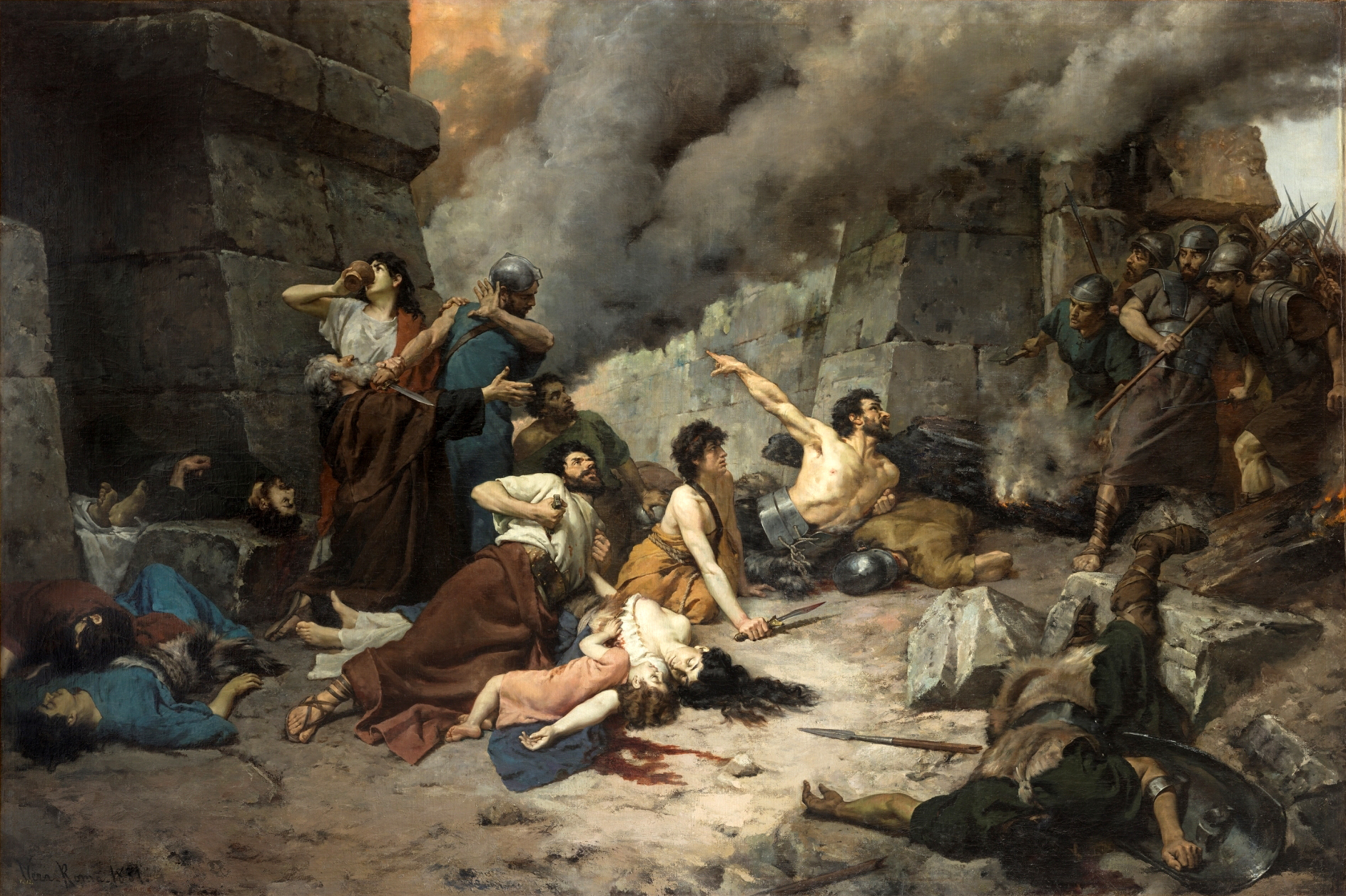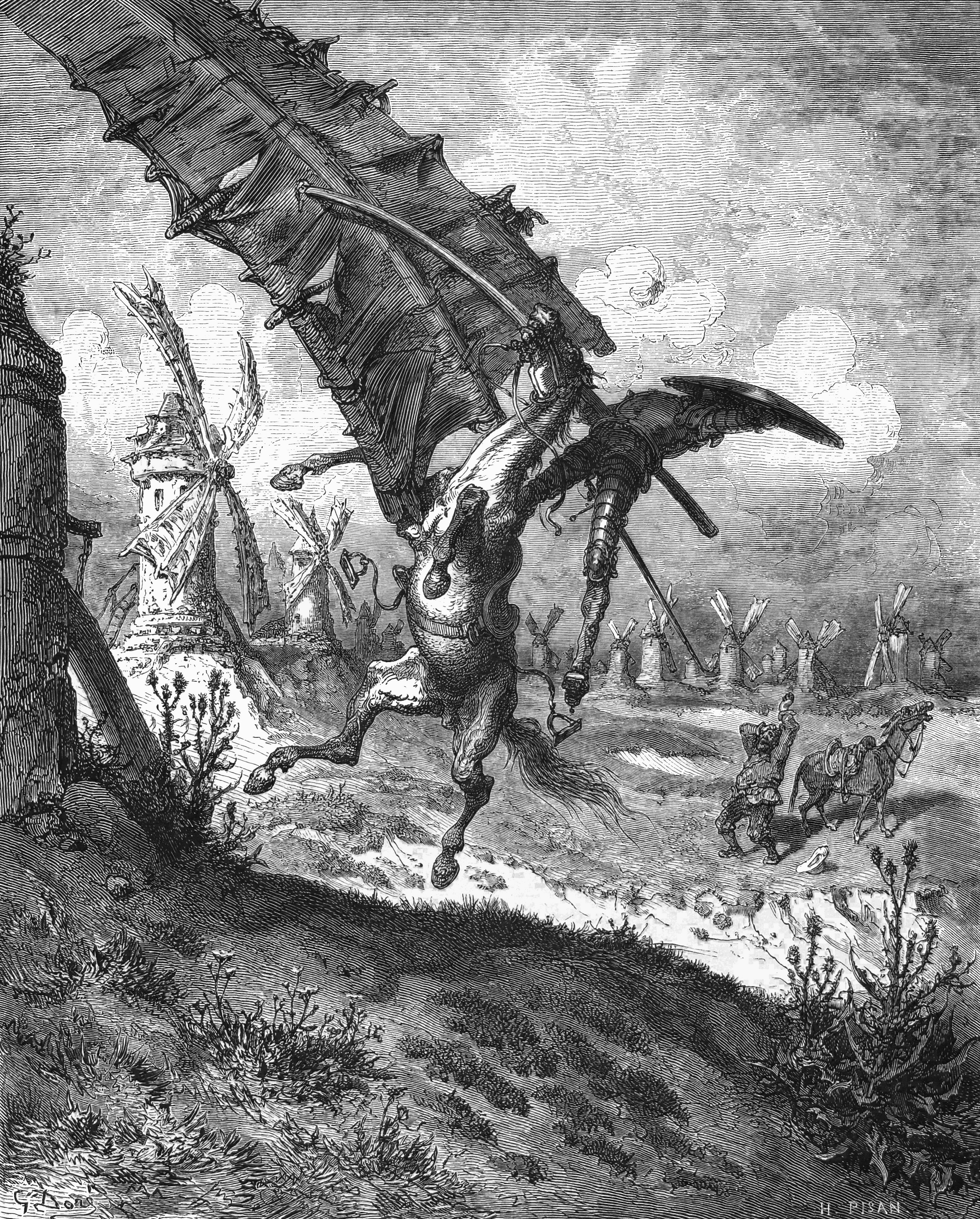|
Siege Of Numantia
The Celtiberian oppidum of Numantia was attacked more than once by Roman forces, but the siege of Numantia refers to the culminating and pacifying action of the long-running Numantine War between the forces of the Roman Republic and those of the native population of Hispania Citerior. The Numantine War was the third of the Celtiberian Wars and it broke out in 143 BC. A decade later, in 133 BC, the Roman general and hero of the Third Punic War, Scipio Aemilianus Africanus, subjugated Numantia, the chief Celtiberian city. Roman preparation In late 135 BC, the Roman Senate reappointed Scipio consul on popular demand and sent him to Hispania to finish what lesser generals had failed to complete. Scipio found morale low among the troops stationed in Iberia. The chance of plunder being low, there were few enticements to enlistment. Scipio nevertheless raised an army of 20,000 with 40,000 allied and mercenary troops, especially Numidian cavalry and 12 elephants led by Jugurt ... [...More Info...] [...Related Items...] OR: [Wikipedia] [Google] [Baidu] |
Numantine War
The Numantine WarThe term Numantine War can refer to the whole conflict lasting from 154 to 133 or to just the latter part, from 143 to 133. Thus, the two conflicts are sometimes called the Numantine Wars (plural) and subdivided into the First and Second Numantine War. The two are also called the Second and Third Celtiberian (or Spanish) Wars. (from ''Bellum Numantinum'' in Appian's ''Roman History'') was the last conflict of the Celtiberian Wars fought by the Romans to subdue those people along the Ebro, in what is now Spain. It was a twenty-year conflict between the Celtiberian tribes of Hispania Citerior and the Roman government. It began in 154 BC as a revolt of the Celtiberians of Numantia on the Douro. The first phase of the war ended in 151, but in 143, war flared up again with a new insurrection in Numantia. The first war was fought contemporaneously with the Lusitanian War in Hispania Ulterior. The Lusitanians were subdued by Sulpicius Galba, who betrayed their sur ... [...More Info...] [...Related Items...] OR: [Wikipedia] [Google] [Baidu] |
Consul
Consul (abbrev. ''cos.''; Latin plural ''consules'') was the title of one of the two chief magistrates of the Roman Republic, and subsequently also an important title under the Roman Empire. The title was used in other European city-states through antiquity and the Middle Ages, in particular in the Republics of Genoa and Pisa, then revived in modern states, notably in the First French Republic. The related adjective is consular, from the Latin '' consularis''. This usage contrasts with modern terminology, where a consul is a type of diplomat. Roman consul A consul held the highest elected political office of the Roman Republic (509 to 27 BC), and ancient Romans considered the consulship the highest level of the '' cursus honorum'' (an ascending sequence of public offices to which politicians aspired). Consuls were elected to office and held power for one year. There were always two consuls in power at any time. Other uses in antiquity Private sphere It was not uncommon ... [...More Info...] [...Related Items...] OR: [Wikipedia] [Google] [Baidu] |
Spanish Ship Numancia
Three ships of the Spanish Navy have borne the name ''Numancia'', after the Siege of Numantia of 134–133 BC during the Numantine War: *''Numancia'', ex-, a 74-gun ship of the line purchased from the Imperial Russian Navy in 1818, disarmed in 1820, and sold in 1822. *, an armoured frigate, a type of broadside ironclad, commissioned in 1864 and stricken in 1912, the first ironclad warship to circumnavigate Circumnavigation is the complete navigation around an entire island, continent, or astronomical body (e.g. a planet or moon). This article focuses on the circumnavigation of Earth. The first circumnavigation of the Earth was the Magellan Exped ... the world. *, a commissioned in 1989. {{DEFAULTSORT:Numancia, Spanish Ship Spanish Navy ship names ... [...More Info...] [...Related Items...] OR: [Wikipedia] [Google] [Baidu] |
Carlos Fuentes
Carlos Fuentes Macías (; ; November 11, 1928 – May 15, 2012) was a Mexican novelist and essayist. Among his works are ''The Death of Artemio Cruz'' (1962), '' Aura'' (1962), '' Terra Nostra'' (1975), '' The Old Gringo'' (1985) and '' Christopher Unborn'' (1987). In his obituary, ''The New York Times'' described Fuentes as "one of the most admired writers in the Spanish-speaking world" and an important influence on the Latin American Boom, the "explosion of Latin American literature in the 1960s and '70s", while ''The Guardian'' called him "Mexico's most celebrated novelist". His many literary honors include the Miguel de Cervantes Prize as well as Mexico's highest award, the Belisario Domínguez Medal of Honor (1999). He was often named as a likely candidate for the Nobel Prize in Literature, though he never won. Life and career Fuentes was born in Panama City, the son of Berta Macías and Rafael Fuentes, the latter of whom was a Mexican diplomat. As the family moved for hi ... [...More Info...] [...Related Items...] OR: [Wikipedia] [Google] [Baidu] |
La Numancia
''The Siege of Numantia'' () is a tragedy by Miguel de Cervantes set at the siege of Numantia, captured and razed by Scipio Aemilianus in 133 BC. The play is divided into four acts, (''jornadas'', or "days"). The dialogue is sometimes in tercets and sometimes in ''redondillas'', but for the most part in octaves. The work was composed ''circa'' 1582 and was apparently very successful in the years before the advent of the playwright Lope de Vega. It remained unpublished until the eighteenth-century. Since then, it has been hailed by many as a “rare specimen of Spanish tragedy” and even as the best Spanish tragedy not only from the period before Lope de Vega, but of all its literature. Some critics have seen resemblances between Cervantes' tragedy and Aeschylus's ''The Persians'', while others reject that the play is a conventional tragedy. Some envision the play as containing epic elements or even exhibiting opposing epics: Virgil's ''Aeneid'' and Lucan's ''Pharsalia'', ... [...More Info...] [...Related Items...] OR: [Wikipedia] [Google] [Baidu] |
Don Quixote
, the full title being ''The Ingenious Gentleman Don Quixote of La Mancha'', is a Spanish novel by Miguel de Cervantes. Originally published in two parts in 1605 and 1615, the novel is considered a founding work of Western literature and is often said to be the first modern novel. The novel has been labelled by many well-known authors as the "best novel of all time" and the "best and most central work in world literature". ''Don Quixote'' is also one of the List of literary works by number of translations, most-translated books in the world and one of the List of best-selling books, best-selling novels of all time. The plot revolves around the adventures of a member of the lowest nobility, an Hidalgo (nobility), hidalgo from La Mancha named Alonso Quijano, who reads so many chivalric romances that he loses his mind and decides to become a knight-errant () to revive chivalry and serve his nation, under the name . He recruits as his squire a simple farm labourer, Sancho Panza, wh ... [...More Info...] [...Related Items...] OR: [Wikipedia] [Google] [Baidu] |
Miguel De Cervantes
Miguel de Cervantes Saavedra ( ; ; 29 September 1547 (assumed) – 22 April 1616 Old Style and New Style dates, NS) was a Spanish writer widely regarded as the greatest writer in the Spanish language and one of the world's pre-eminent novelists. He is best known for his novel ''Don Quixote'', a work considered as the first modern novel. The novel has been labelled by many well-known authors as the "best book of all time" and the "best and most central work in world literature". Much of his life was spent in relative poverty and obscurity, which led to many of his early works being lost. Despite this, his influence and literary contribution are reflected by the fact that Spanish is often referred to as "the language of Cervantes". In 1569, Cervantes was forced to leave Spain and move to Rome, where he worked in the household of a Cardinal (Catholic Church), cardinal. In 1570, he enlisted in a Spanish Marine Infantry, Spanish Navy infantry regiment, and was badly wounded at th ... [...More Info...] [...Related Items...] OR: [Wikipedia] [Google] [Baidu] |
Arevaci
The Arevaci or Aravaci (''Arevakos'', ''Arvatkos'' or ''Areukas'' in the Greek language, Greek sourcesPtolemy, ''Geographiké Hyphegésis'', II, 6, 55.), were a Celts, CelticCremin, ''The Celts in Europe'' (1992), p. 57. people who settled in the Geography of Spain#The Inner Plateau and associated mountains, central Meseta of northern Hispania and dominated most of Celtiberia from the 4th to late 2nd centuries BC. The Vaccaei were their allies. Origins The Arevaci were of Celts, Celtic origin and part of the group of peoples known as the Celtiberians. There is an overwhelming amount of evidence that the ancestors of the Celtiberian groups were installed in the Meseta area of the Iberian Peninsula from at least 1000 BC and probably much earlier. Some think their ancestors were early ‘Celtic languages#Classification, Q-Celtic’ speakers from Gaul who migrated to the peninsula around the mid-6th century BC, arriving at about the same time as the powerful Vaccaei people ... [...More Info...] [...Related Items...] OR: [Wikipedia] [Google] [Baidu] |
Duero
The Douro (, , , ; ; ) is the largest river of the Iberian Peninsula by discharge. It rises near Duruelo de la Sierra in the Spanish province of Soria, meanders briefly south, then flows generally west through the northern part of the Meseta Central in Castile and León into northern Portugal. Its largest tributary (carrying more water than the Douro at their confluence) is the right-bank Esla. The Douro flows into the Atlantic Ocean at Porto, the second largest city of Portugal. The scenic Douro railway line runs close to the river. Adjacent areas produce port (a mildly fortified wine) and other agricultural produce. A small tributary of the river has the Côa Valley Paleolithic Art site which is considered important to the archaeological pre-historic patrimony, designated a UNESCO World Heritage Site. Within Spain, it flows through the middle of the autonomous community of Castile and León, with the basin spanning through the northern half of the Meseta Central. The la ... [...More Info...] [...Related Items...] OR: [Wikipedia] [Google] [Baidu] |
Contravallation
Investment is the military process of surrounding an enemy fort (or town) with armed forces to prevent entry or escape. It serves both to cut communications with the outside world and to prevent supplies and reinforcements from being introduced. A contravallation is a line of fortifications built by the attackers around the besieged fortification facing towards an enemy fort to protect the besiegers from sorties by its defenders and to enhance the blockade. The contravallation can be used as a base to launch assaults against the besieged city or to construct further earthworks nearer to the city. A circumvallation may be constructed if the besieging army is threatened by a field army allied to an enemy fort. It is a second line of fortifications outside the contravallation that faces away from an enemy fort. The circumvallation protects the besiegers from attacks by allies of the city's defenders and enhances the blockade of an enemy fort by making it more difficult to smuggl ... [...More Info...] [...Related Items...] OR: [Wikipedia] [Google] [Baidu] |




